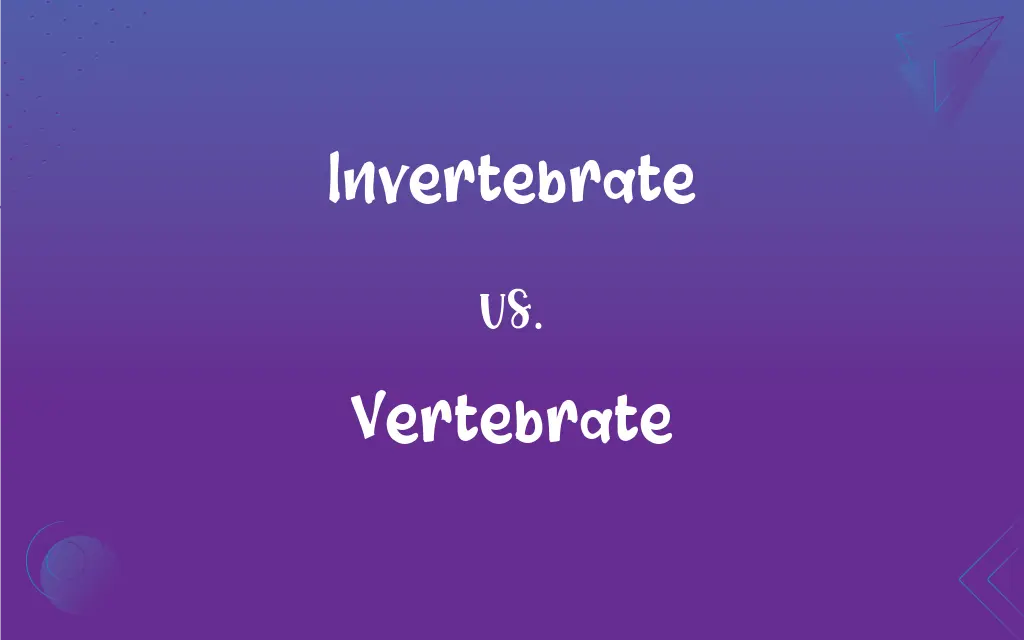Invertebrate vs. Vertebrate: What's the Difference?
Edited by Aimie Carlson || By Janet White || Published on January 7, 2024
Invertebrates lack a backbone or spinal column, while vertebrates possess a backbone and spinal column.

Key Differences
Invertebrates do not have a vertebral column (backbone), whereas vertebrates are characterized by their spinal column, a series of vertebrae extending from the skull to the tail.
Invertebrates include a wide range of animals like insects, mollusks, and arachnids, while vertebrates encompass mammals, birds, reptiles, amphibians, and fish.
The invertebrate group is highly diverse, comprising about 95% of all animal species, while vertebrates, though fewer in number, show higher complexity in body organization and systems.
Invertebrates are found in almost every habitat on Earth, adapting to a wide range of environments. Vertebrates are also adaptable but are often larger and require more complex habitats.
Invertebrates often have simpler bodily functions and systems, while vertebrates exhibit more complex systems like advanced nervous, respiratory, and circulatory systems.
ADVERTISEMENT
Comparison Chart
Spinal Structure
Lack a backbone or spinal column
Possess a backbone and spinal column
Examples
Insects, mollusks, arachnids
Mammals, birds, reptiles, amphibians, fish
Species Diversity
Comprise about 95% of all animal species
Fewer in number, but more complex
Habitat Adaptation
Found in diverse habitats
Require more complex habitats
Biological Complexity
Simpler body systems
More advanced and complex body systems
ADVERTISEMENT
Invertebrate and Vertebrate Definitions
Invertebrate
Invertebrates include a vast range of species, typically without a rigid skeleton.
Snails, as invertebrates, have a soft body without a vertebral column.
Vertebrate
Vertebrates represent a smaller, yet more complex group of animals.
Birds, a group of vertebrates, have complex respiratory systems.
Invertebrate
Invertebrates can be found in various habitats, from oceans to deserts.
Coral reefs are home to many invertebrates.
Vertebrate
Vertebrates include animals that live in various environments, like land and water.
Fish, as vertebrates, have well-developed skeletal systems.
Invertebrate
Invertebrates encompass the majority of animal species on Earth.
Invertebrates like bees play crucial roles in ecosystems.
Vertebrate
Vertebrates are distinguished by their complex body systems and structures.
The lion, a vertebrate, has a highly developed nervous system.
Invertebrate
An invertebrate is an animal lacking a backbone, like insects or jellyfish.
A butterfly is an example of an invertebrate.
Vertebrate
A vertebrate is an animal with a backbone, such as mammals and birds.
Humans are vertebrates, characterized by their spinal column.
Invertebrate
An invertebrate's body structure is less complex than vertebrates.
The earthworm, an invertebrate, has a simple body plan.
Vertebrate
Vertebrates often have advanced adaptive features and behaviors.
Dolphins, vertebrates, show high levels of intelligence and social behavior.
Invertebrate
Lacking a backbone or spinal column; not vertebrate.
Vertebrate
Having a backbone or spinal column.
Invertebrate
Of or relating to invertebrates
Invertebrate zoology.
Vertebrate
Of or characteristic of vertebrates or a vertebrate.
Invertebrate
An animal, such as an insect or mollusk, that lacks a backbone or spinal column.
Vertebrate
Any of numerous chordate animals of the subphylum Vertebrata, characterized by a segmented spinal column and a distinct well-differentiated head. The vertebrates include the fishes, amphibians, reptiles, birds, and mammals.
Invertebrate
An animal without vertebrae, i.e. backbone.
Vertebrate
Having a backbone.
Invertebrate
(informal) A spineless person; a coward.
Vertebrate
An animal having a backbone.
Invertebrate
Lacking a backbone; without vertebrae.
Vertebrate
One of the Vertebrata.
Invertebrate
Cowardly, uncourageous; lacking character.
Vertebrate
Having a backbone, or vertebral column, containing the spinal marrow, as man, quadrupeds, birds, amphibia, and fishes.
Invertebrate
Destitute of a backbone; having no vertebræ; of or pertaining to the Invertebrata.
Vertebrate
Contracted at intervals, so as to resemble the spine in animals.
Invertebrate
Any animal lacking a backbone or notochord; the term is not used as a scientific classification
Vertebrate
Having movable joints resembling vertebræ; - said of the arms of ophiurans.
Invertebrate
Lacking a backbone or spinal column;
Worms are an example of invertebrate animals
Vertebrate
Of or pertaining to the Vertebrata; - used only in the form vertebrate.
Vertebrate
Animals having a bony or cartilaginous skeleton with a segmented spinal column and a large brain enclosed in a skull or cranium
Vertebrate
Having a backbone or spinal column;
Fishes and amphibians and reptiles and birds and mammals are verbetrate animals
FAQs
How diverse are invertebrates?
Extremely diverse, making up about 95% of all animal species.
How complex are vertebrates?
They have complex body systems and higher biological organization.
What defines an invertebrate?
Animals lacking a backbone or vertebral column.
What are examples of vertebrates?
Mammals, birds, fish, reptiles, and amphibians.
What kind of reproduction is common in vertebrates?
Both sexual and asexual, depending on the species.
What defines a vertebrate?
Animals possessing a backbone and spinal column.
Do vertebrates live in diverse habitats?
Yes, but they often require more specialized habitats.
Do invertebrates have a skeleton?
Some do, like exoskeletons in insects, but no internal backbone.
Do invertebrates have a nervous system?
Yes, but it's generally simpler than in vertebrates.
Can invertebrates live in any habitat?
Yes, they're found in almost all environments on Earth.
Are vertebrates more advanced than invertebrates?
In terms of body structure and systems, generally yes.
Do invertebrates have blood?
They have fluids performing similar functions, but not true blood.
What are examples of invertebrates?
Insects, spiders, snails, and jellyfish.
Do vertebrates play a specific role in ecosystems?
Yes, they often occupy key roles in food chains and ecosystems.
Are vertebrates important for human research?
Yes, they are crucial in medical and biological research.
Are all vertebrates warm-blooded?
No, only mammals and birds; reptiles and fish are cold-blooded.
Can vertebrates be herbivores, carnivores, or omnivores?
Yes, vertebrates can have varied diets.
What's the largest group of invertebrates?
Insects are the largest and most diverse group.
Can invertebrates be microscopic?
Yes, many invertebrates are microorganisms.
How do invertebrates contribute to biodiversity?
They are crucial for ecological balance, pollination, and soil health.
About Author
Written by
Janet WhiteJanet White has been an esteemed writer and blogger for Difference Wiki. Holding a Master's degree in Science and Medical Journalism from the prestigious Boston University, she has consistently demonstrated her expertise and passion for her field. When she's not immersed in her work, Janet relishes her time exercising, delving into a good book, and cherishing moments with friends and family.
Edited by
Aimie CarlsonAimie Carlson, holding a master's degree in English literature, is a fervent English language enthusiast. She lends her writing talents to Difference Wiki, a prominent website that specializes in comparisons, offering readers insightful analyses that both captivate and inform.







































































